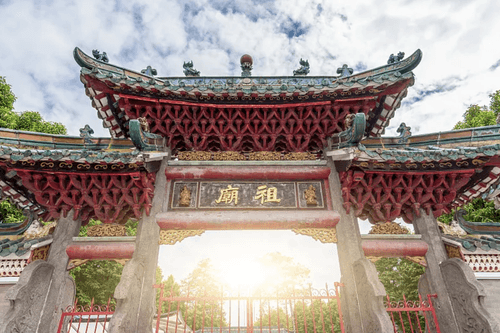
Foshan Ancestral Temple: A Timeless Palace of Lingnan Art and Martial Arts
🌟 Introduction: Why Foshan Ancestral Temple is Your Must-Visit Destination
Dear fellow travelers, are you a curious soul tired of homogenized cityscapes? Do you crave a deep dive into authentic culture, yearning to touch the very roots of a destination? If your answer is yes, then set your sights on Foshan in Guangdong, China—the heart of the city conceals an ancient, vibrant treasure: the Foshan Ancestral Temple (Zumiao).
This is more than just a temple; it is a living history book of the Lingnan (Southern China) region, a cradle of martial arts legends, and a spectacular showcase of folk artistry.
Why is this sacred site a global must-see for you?
An Unparalleled Artistic Treasury: The Temple is rightly hailed as the "Palace of Oriental Art." It preserves the finest examples of Lingnan architecture, a mesmerizing blend of five distinct carving arts (Wood, Brick, Stone, Pottery, and Plaster). Every detail is a masterpiece forged by ancient craftsmen.
A Global Kung Fu Pilgrimage: This is the spiritual home of martial arts. As the location of the memorial halls dedicated to two world-renowned martial arts grandmasters—Wong Fei Hong and Ip Man—the Temple is a vital cultural address for understanding the philosophy and global impact of Chinese Kung Fu.
An Immersive Cultural Extravaganza: Prepare to feel the raw energy of Chinese culture by witnessing the spectacular Lion Dance performance—a National Intangible Cultural Heritage. The thundering drums, the acrobatics, and the sheer vitality are an experience you won't find anywhere else.
Today, let me be your guide into this magnificent, thousand-year-old sanctuary.
I. The Whisper of History: From God of Water to "Ancestral Temple"
The history of the Ancestral Temple is long and deeply rooted in the local community, dating back to the Northern Song Dynasty (1078–1085 AD).
The Patron Saint: The Northern Emperor (Beidi)
The Temple was originally a place of worship for the Taoist deity Zhenwu Xuantian Shangdi, known as the Northern Emperor or God of Water. Foshan, historically a hub for shipping, industry, and commerce, often faced the threat of floods. The powerful North Emperor, believed to command the element of water, became the community's primary protector and source of blessing, ensuring peace and prosperity.
The Meaning of "Zumiao": The Premier Temple
After several reconstructions and expansions, especially during the Ming and Qing Dynasties, the temple grew to become the largest and most influential sanctuary in the area. Local people began to call it "Zumiao," literally the "Ancestral Temple," signifying its status as the most senior and foremost temple in Foshan. Before formal local governments were established in the Qing Dynasty, the Zumiao even functioned as a community center for important political and civic discussions, extending its role far beyond religion. To understand the "soul" of Foshan, you must begin here.
II. An Architectural Feast: Walking through the Palace of Oriental Art
The designation of "Palace of Oriental Art" is perfectly fitting for the Ancestral Temple. It stands as a prime example of Lingnan architecture—a distinct regional style from South China—characterized by its complex structure and phenomenal decorative arts.
The main complex follows a strict central axis, featuring the Wanfu Stage (Opera Stage), the Lingying Archway, the Jinxiang Pool, the Bell and Drum Towers, the Front Hall, and the Main Hall.
🎨 A Deep Dive into the Five Carving Arts (The "Five Carvings and One Sculpture")
Take your time to appreciate the sheer volume and intricacy of the decorative arts that cover every surface. This "five carvings and one sculpture" technique is the height of ancient Lingnan craftsmanship:
Stone Carving (Shi Diao): Admire the strength and detail on the stone columns, railings, and bases. The carvings often depict mythical beasts and historical narratives, showing the artists' ability to render dynamic life from the toughest material.
Brick Carving (Zhuan Diao): Look closely at the walls and entrances. Master brick carvers used delicate relief and openwork techniques on blue bricks to create sophisticated, almost painterly scenes of landscapes and figures. These pieces reflect an understated elegance and precision.
Wood Carving (Mu Diao) – The Gold Leaf Art: The most opulent carvings are found on the doors, windows, and altar canopies. The signature style here is Gold-Leaf Wood Carving—intricate three-dimensional scenes, often from famous operas or legends, covered in dazzling gold foil. They shine brilliantly, symbolizing blessing, prosperity, and power.
Pottery Sculpture (Tao Su) – Shiwan Ceramics: Found primarily on the ridge of the roof, this is the most colorful and uniquely Foshan art form. These sculptures, fired from the famous Shiwan Kilns, feature brightly glazed ceramic figures. They are highly expressive, almost theatrical, depicting gods, historical characters, and animals, essentially creating miniature, permanent opera scenes frozen atop the architecture.
Plaster Sculpture (Hui Su): Located on the edges of the rooflines and gables, these are made from a mixture of lime and other materials. While less colorful than the pottery, they create sweeping, fluid designs of clouds, dragons, and flowers, adding a sense of lightness and movement to the heavy structure.
Finally, in the Main Hall, stand before the colossal Bronze Statue of the Northern Emperor. Cast in the Ming Dynasty and weighing three tons, it is a magnificent testament to Foshan’s ancient fame as a center for metal casting and foundry.
III. The Pulse of Culture: Martial Arts, Philosophy, and Folk Traditions
The Temple’s magnetic appeal lies not just in its ancient stones, but in its vibrant role as a living museum of Lingnan culture.
🥋 A Martial Arts Pilgrimage: Ip Man and Wong Fei Hong
Foshan is recognized globally as the "Home of Martial Arts." The presence of two dedicated memorial halls makes the Ancestral Temple a pilgrimage site for Kung Fu devotees worldwide.
Wong Fei Hong Memorial Hall:
Dedicated to Wong Fei Hong, a master of the Hong Family Fist (Hung Gar) and a revered traditional Chinese physician. The museum showcases his life, medical achievements, and legendary status immortalized in countless films. His philosophy embodies "Xia Zhi Dazhe"—the spirit of the great hero—combining formidable martial skill with a doctor's compassion and a righteous moral code.
Ip Man Hall:
This hall honors Ip Man (Yè Wèn), the Grandmaster of the unique and highly effective Wing Chun style and the teacher of global icon Bruce Lee. The exhibit delves into his life and the core philosophy of Wing Chun.
The Philosophy of Wing Chun: Wing Chun is built on the principles of "Centerline Theory," "Deflecting Force," and "Using Softness to Overcome Hardness." It is not about brute strength but about efficiency, economy of motion, and adaptability—a martial art rooted in Taoist principles of balance and harmony, demonstrating that intellect and skill can triumph over raw power. This unique blend of philosophy and combat is what gave Ip Man and his protégé Bruce Lee their profound global cultural impact.
🦁 The Must-See: The Thundering Lion Dance
You absolutely cannot leave without witnessing the world-famous Foshan Lion Dance (Xingshi), a National Intangible Cultural Heritage. Foshan is the birthplace of the Southern Lion style, known for its martial arts foundation and acrobatic movements.
Daily Performance Schedule:
To ensure you catch this exhilarating show, check the times for the combined Martial Arts and Lion Dance performance:
Morning Show: 10:00 AM – 10:40 AM
Afternoon Show 1: 2:15 PM – 2:55 PM
Afternoon Show 2: 3:30 PM – 4:10 PM
(Note: Performance times are subject to change due to weather or special events. Please confirm the schedule upon entry and arrive early to secure a good spot!)
The thunder of the drums, the clash of the cymbals, and the dazzling lion costume leaping across high poles in the Wanfu Stage courtyard is a breathtaking spectacle of power, rhythm, and auspicious energy—a true celebration of Chinese tradition, signifying good fortune and warding off evil spirits.
IV. Recommended Visitor Route: Your Ancestral Temple Journey
Follow this route to ensure you capture all the highlights in a smooth 2-3 hour visit:
Entrance & Lingying Archway: Begin by passing under the majestic Archway, a symbol of imperial favor.
Wanfu Stage: Head here first to check the schedule and secure your viewing spot for the Lion Dance performance.
Wong Fei Hong Memorial Hall: Start your Kung Fu journey by learning about Grandmaster Wong Fei Hong and the spirit of chivalry.
Main Temple Complex (The Three Gates, Front Hall, Main Hall): Move along the central axis. Focus your attention upward to admire the incredible architectural artistry—the vibrant pottery and elegant plaster sculptures on the roofs. In the Main Hall, pay respects to the immense Northern Emperor Bronze Statue.
Qingzhen Tower & Jinxiang Pool: Circle to the back to see the tranquil courtyard and pond area.
Ip Man Hall: Conclude your martial arts tour by exploring the life and Wing Chun philosophy of Grandmaster Ip Man.
Confucius Temple (Kong Miao): If time permits, visit the Confucius Temple nearby to understand the influence of Confucianism on local culture.
V. Practical Information: Address and Transport
The Foshan Ancestral Temple is conveniently located in the city center, making it highly accessible for international travelers.
Address:
No. 21 Zumiao Road, Chancheng District, Foshan City, Guangdong Province, China
Transport:
The easiest way to arrive is via the Guangfo Metro Line. Get off at Zumiao Station (祖庙站), and take Exit A or C. The temple entrance is just a short walk away.
Opening Hours & Admission:
Opening Hours: Generally 8:30 AM – 6:00 PM
Admission Fee: Approximately 20 RMB (Please check the official site for current pricing)
Conclusion: An Invitation from Foshan
The Foshan Ancestral Temple is a place where history, art, and living culture converge. It stands as a steady old sage in the bustling city, using its exquisite carvings to tell stories and its martial arts legacy to transmit the vitality of Lingnan heritage.
When you walk through the temple grounds, you are not just visiting a site; you are engaging in a spiritual dialogue with the principles upheld by legends like Wong Fei Hong and Ip Man, and you are celebrating the craftsmanship of generations past.
Pack your bags and prepare for a journey. The Ancestral Temple promises not just a sightseeing stop, but a profound cultural experience that will leave you with a deeper appreciation for the artistry, philosophy, and enduring spirit of Southern China. We hope to see you in Foshan!


